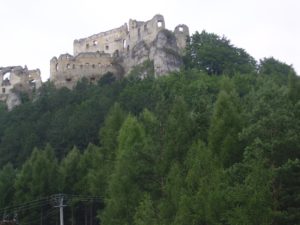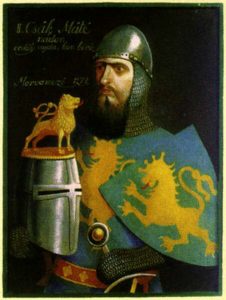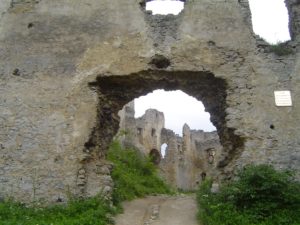Zsolnalitva

Zsolnalitva is the third-largest castle in the Upper lands/Horná Zem/Felvidék, in Slovakia, and is called Lietava. It is one of the biggest Hungarian castles in the Renaissance style. It is nine km from Zsolna and was built by the Balassa family in the first part of the 13th century on an ancient fort site, after the Mongolian invasion of 1241-42. The Balassa Clan of the Zólyom Valley used to be the greatest family in the area, and they built further castles to defend their lands: Óvár, Budatin, and Szucsány. The Balassa family soon gained the Castle of Hricsó as well, so they became the biggest landowners in Trencsén County.
Location: https://tinyurl.com/3bye5nek
In the age of the Balassa Clan, Zsolnalitva (or Litva) Castle consisted of only a stone tower and a stone wall. The rise of the mighty Csák family began in 1297 when they took Trencsén Castle by bribing the king’s castellan. Soon he became the Palatine of the Kingdom of Hungary, but King Endre III dismissed him soon because of his aggressive land-takings.
Nevertheless, Lord Csák Máté began to build up his little domain in North Hungary. He became the strongest supporter of the new king, who awarded him Nyitra County and Bajmóc Castle as well in 1302. Soon, the oligarch was able to take the lands and the forts in the Vág Valley of the Zólyomi Balassa family. In 1318, Lord Csák placed his castellan in Litva Castle, a man named Ludányi Endre.

The castle was owned by Csák Máté until he died in 1321. The army of King Károly Róbert took the lands of the oligarch back, led by Miklós, son of Amadé of the Gutkeled Clan. King Károly Róbert returned the castles to the Balassa family, namely to Péter, son of Byter, and György, son of Miklós. These castles were Budetin, Hricsó, Zsolnalitva, Szucsány, Óvár (aka Várna), as well as the Castle of Kékkő at the Ipoly River, including Hídvég and Gyarmat. However, the king reconsidered his generosity and took Litva and a few more castles back in 1323.

After 1323, Litva belonged to the Comes of Vágbeszterce, along with Budatin, Hricsó, and Sztrecsnó. These forts were controlled by the Judge of the Country, and his office received the taxes from their lands, too. This Judge was Köcski Sándor in 1325, the Comes of Beszterce, the owner of the village called Divina next to Litva Castle.
Later, Divina was owned by Judge Nagymartoni Pál in 1349, but it was owned by Judge Szécsényi Tamás in 1351; this is how we can trace who was in charge of Litva Castle at this time. We do not know the name of the king’s castellan of Litva Castle in 1384, but we know that his liege lords were Pósafi Miklós and István, Comes of Sztrecsnó Castle. Please note that I am using the Eastern name order for Hungarian names, where the family names come first.
The lands of the castle were owned by Serkei Dezső between 1392 and 1397. We know the names of three of his castellans: Szúcsai {Zwchay} László, Kusza {Cuza} András, and Zyby István. However, in 1397, King Zsigmond gave Litva and other lands to the Polish Sedziwoj Kaliszi of Szubin. He was its owner at least until 1403. We don’t know its owner until 1418 when it was in the hands of Lord Junior Stibor, but it was given to Queen Borbála of Cille, wife of King Zsigmond. We know the letter she wrote to Kassa in which she asked for help to beat out the Bohemian Hussite mercenaries from Litva Castle because they had taken it.

Yet, it was the Queen who pledged the castle to her captain, the Polish Dunin of Skrzynno, in 1437, and he owned it until 1439. Then, the Queen pledged it to the Polish lord called Miklós of Stiboric in 1440. According to contemporary sources, the castle belonged to Wlodko and his wife, Katalin, before 1460. The new king, Matthias Corvinus, gave it to his general, Kinizsi Pál, in 1474. You can see the Kinizsi family’s stone Coat of Arms on the wall of Litva. Kinizsi received Sztrecsnó Castle as well, in exchange for his heroic deeds against the Poles during the king’s campaign to Bohemia. You can read more about these campaigns here:
https://www.hungarianottomanwars.com/essays/king-matthias-at-boroszlo-wroclaw-breslau/

Kinizsi Pál, the Judge of the Country, happened to die without an heir in 1494. His lively widow, Lady Magyar Benigna, was just 20 and soon remarried a nobleman called Horváth Márk. The poor man fell off his horse in Zágráb and broke his neck in 1508. Lady Benigna found a new husband in 1509, he was Kereky Gergely. The man turned out to be a cruel and tyrannical husband, so the Lady had him killed with her men and threw him into the moat in 1519. As a result of this, she was sentenced to death. However, young King Louis II (the one who later died at Mohács in 1526) gave her a pardon. She had to spend the rest of her life in the Castle of Litva, where she died in 1523.

Later in 1523, it went to the Szapolyai family, who improved it in Renaissance style. After the Battle of Mohács, Szapolyai János, the voivode of Transylvania, became the king of Hungary. He was attacked by Habsburg Ferdinand, and the Dual Kingship began to tear the kingdom apart. King Szapolyai pledged Litva Castle and the lands of Sztrecsnó to Captain Kosztka Miklós. The Polish Kosztka brothers held Árva, Turóc, Trencsén, and Liptó counties on King Szapolyai’s side. Their soldiers guarded the castles of Sztrecsnó, Árva (Orava), Zsolnalitva, Znió, and Szucsány as well as the town of Zsolna.

The Podmaniczky brothers supported them, and together they were strong enough to fight off the power of the Thurzó and the Révay families,s who were on King Ferdinand’s side. King Ferdinand failed to bribe the Kosztka brothers and made a contract with a Moravian lord called Jan Perstein, who took arms against the men of Szapolyai. The lord was supposed to keep the lands he had taken, according to the contract.

General Salm defeated the army of King Szapolyai on 27 September 1527 and at Abaújszinán on 8 March 1528 as well, so the castles of the king were taken one by one. The troops of General Katzienger and Lord Török Bálint advanced on and besieged Trencsén Castle in April. Trencsén was defended by Captain Baracskay Pál and Captain Kozár, and even King Szapolyai sent a reinforcement that was eventually defeated by the German mercenaries. Within a month, the heavy artillery fire damaged the walls of Trencsén severely, and there was no food or gunpowder left inside, so the defenders had to surrender this strategic fort.

General Johann Katzianer became the Comes of Trencsén County in the service of the usurper King Ferdinand, and he soon took Litva castle by the sword after a one-month-long siege in 1528. His troops were led by Captain Turi Márton, though. Then, Katzianer set Litva on fire and marched away. Fortunately, Litva Castle was restored by Kosztka Miklós, who also placed a garrison in it. King Szapolyai was coming back from Poland as his military leader, Scribe Athinai Simon, defeated the men of Chief Captain Révay István on 29 September 1528, thus trying to pave the way to his homecoming.

The troops of the Moravian Jan Steinberg joined in the fights in 1530, and there were sieges and battles until 1532. Lord Kosztka Miklós was resisting as long as he could, but he had to make a truce with the Habsburgs in Teschen in November 1532. Kosztka was allowed to keep only the castles of Árva, Szucsány, Sztrecsnó, and the city of Zsolna. Here you can read more about Árva Castle: https://www.hungarianottomanwars.com/kingdom-of-hungary/arva/
However, Lord Kosztka managed to control Árva County for several years, until 1544. The Habsburgs’ men assaulted Liptó in 1538 but they were repelled by Kosztka’s garrison. One must wonder how much blood was wasted in these fights during the days of the imminent Ottoman peril. When King Habsburg Ferdinand appointed Báthori András as the owner of Zsolnalitva Castle, it was the aged Lord Kosztka Miklós who gave such a hard beating to him that the king’s man died from his injuries. The valiant Polish nobleman died in 1556, leaving behind two daughters, Borbála and Anna.
Zsolnalitva Castle during the Habsburg rule

Borbála got married to the wealthy Thurzó Ferenc (former Bishop of Nyitra / Nitra between 1534-1556) because the Pope allowed him to resign from his priestly office. He became the lord of Litva and also gained Árva Castle and its huge domains. He was appointed by King Ferdinand as the Chief Comes of Árva county before 1562. After the death of Borbála, Thurzó wed the 14-year-old Katalin, the daughter of Zrínyi Miklós, aka Nikola Zrinski, the hero of Szigetvár (died in 1566). The wedding took place at Bajmóc Castle, then the happy couple settled in Zsolnalitva Castle. They had five children altogether.

It was the age when the inner palace of the castle was decorated. However, after a few years, Thurzó and Lady Katalin moved to the Castle of Árva, which was rebuilt in Renaissance style, and they embraced the Evangelic faith. When Lord Thurzó died in 1574, Lady Katalin was just 26, and she got married to Lord Forgách Imre. However, Katalin’s brother, Zrínyi György, was opposing this marriage. The angry Zrínyi could gain the right to bring the case to the court concerning the fostering of Katalin’s children. Resultantly, Thurzó Elek and Thurzó Szaniszló became the foster fathers of the children of Thurzó Ferenc. They could even get Árva Castle as well. Thus, Zrínyi Katalin and Forgách Imre had to live in Zsolnalitva Castle until they made peace with Zrínyi György in 1578. After 1579, Lady Katalin could move back to the more comfortable Árva Castle.

There were 21 houses in its village in 1598, and it was the Thurzós’ administrative center until 1641. According to contemporary reports, Litva was guarded only by 12 soldiers in 1602. The Thurzó family’s properties were inherited by Lady Czobor Erzsébet in 1621. Then, in 1626, Lord Illésházy Gáspár was appointed to be in charge of the immense Turzó lands, and he controlled Zsolnalitva until 1648, his death.

Zsolnalitva in the “kuruc” age and after
Litva was regarded as the strongest fort in the area, so the noblemen of Trencsén Castle held their meeting among its walls during the uprising of the “kuruc” Prince Thököly Imre, and also later in 1705. Litva was in the hands of the “kuruc” soldiers of Prince Rákóczi Ferenc between 1703 and 1708 as well. Fortunately, the huge castle was not destroyed by the Habsburgs after the fall of the War of Independence in 1711. It must have been due to the heirs, the Zichy, and the Esterházy family’s efforts, who were loyal to the Habsburgs. Liptó Castle was almost entirely abandoned and left without repair after 1760, though.

Now, Zsolnalitva is the most intact fort of the Vág Valley. It is very nice how the locals joined forces and how they are rebuilding the castle now, many of my fellow Hungarians and other nations in the Carpathian Basin should follow their example.
Watch this video about the castle: https://www.youtube.com/watch?v=AlPAx3L2gDU

Dear Readers, I can only make this content available through small donations or by selling my books or T-shirts.
If you like my writings, please feel free to support me with a coffee here:
You can check out my books on Amazon or Draft2Digital, they are available in hardcover, paperback, or ebook:
https://www.amazon.com/dp/198020490X
or at https://books2read.com/b/boYd81


My work can also be followed and supported on Patreon: Become a Patron!http://Become a Patron!




































